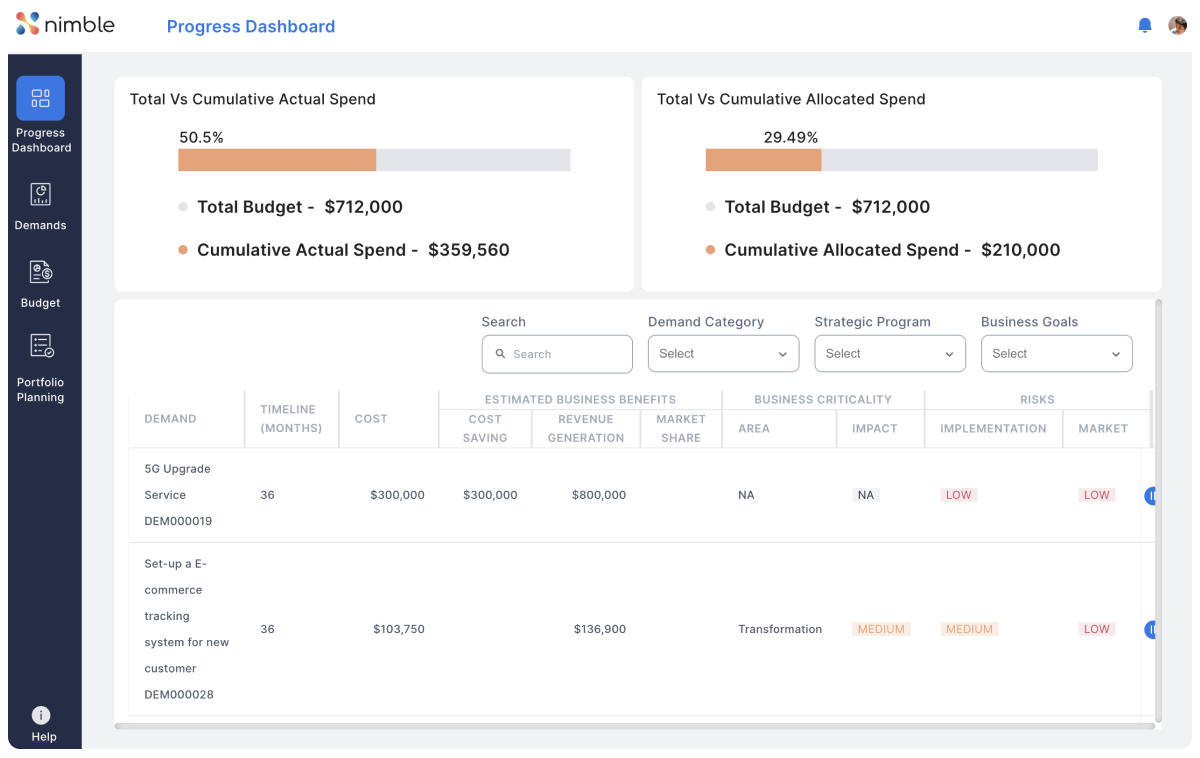What Is Project Portfolio Management (PPM)? A Short Guide
- 6 mins read
-
By Elizabeth Harrin
- Updated on July 29, 2024
Overview
You’ve probably heard about portfolio management and you’re wondering whether it’s worth implementing for your team or organization. You’re in the right place! In this article we’ll explain what project portfolio management is, how it’s used and what benefits you can expect to get (and there are plenty). Plus, we’ll share some of our favorite tools to help you get started putting it into practice.
Project portfolio management is the not-so-secret approach that many of your competitors are using to manage their resource planning, budgeting and strategic delivery. Will you join them?
What is PPM in project management?
If you’ve seen the acronym PPM, it simply stands for project portfolio management, which is also shortened to portfolio management. It’s basically what it says: an approach to managing all projects in an area, team, department or organization, taking a portfolio approach.
The function of PPM is to operate at a higher level in the organization to project or program management. Where are program includes projects that are linked by goals or the vision, a portfolio includes projects and programs that are related in a different way. Typically, the relationships can be boundaried by strategic choices so the individual projects or programs don’t have to relate to each other. For example, the portfolio could cover all work being done by the resources in a division, or all projects being undertaken in the Asia Pacific region.
Portfolios don’t have an end date like projects and programs do: they are a practical grouping of project-based work for investment and reporting purposes.
Clear? Maybe this definition from The Standard for Portfolio Management, 4th Ed from PMI might help further.
“Portfolio management is the centralized management of one or more portfolios to achieve strategic objectives. It is the application of portfolio management principles to align the portfolio and its component with the organizational strategy. Portfolio management can also be viewed as a dynamic activity through which an organization invests its resources to achieve its strategic objectives.”
Basically, it’s having a governance and oversight layer across all projects and programs you’re working on so you can see the whole picture and how it affects the organization – and that’s what makes it such a great approach.
Source: softexpert.com
Reasons why companies Adopt PPM
Why do organizations use PPM? There are lots of reasons why companies adopt project portfolio management including the following.
Oversight at a higher level
Project teams are managing risk, resource and cost at project level, but what does the picture look like aggregated? Portfolio management software lets you aggregate the impact of risk, resource and budgets across all projects so you can see the bigger picture.
Better decision making
When you know everything that is happening, you can make better decisions about what to do next. Maybe the right thing is to speed up a project. Maybe you should be moving resources to a higher priority project. When you can consolidate data from all projects, your decision makers can act on information often before project managers have spotted a problem.
Management of incoming projects
The portfolio management process includes intake of new projects and helps with the decision making. Is the Marketing team already fully occupied on projects or can they manage one more? PPM will tell you, and you can speed up, slow down, stop or add projects as appropriate.
Have we got enough activity happening to meet the strategic sales goals set for the year? PPM reporting will give you that answer, and if you don’t have enough activity, you can kick off the next priority project in the knowledge that it’s the right thing to do.
All kinds of companies benefit from PPM including those with many projects, tech companies and start ups, marketing departments, legal firms, professional services – even small businesses. The larger your company, the more likely it is that you’ll have different portfolios such as one for Europe, one for the Americas and so on.
Who uses PPM?
PPM is an approach that many individuals within the organization benefit from.
Project managers input data to software tools and see their own projects so they can manage more effectively.
Execs and the portfolio office team review the data overall to provide tailored reporting for decision makers that shows how value management is being captured across the portfolio. The more senior the stakeholder, the more likely it is that they will be interested in an investment-centric perspective to ensure the right resources are given to the right projects. Overall, they are looking to ensure the organization moves closer to its strategic goals with each investment and return of benefits.
In a UK study, 52% of businesses predicted growth in project activity, and all those projects need monitoring and controlling somehow! PPM is the answer.
A comprehensive PPM tool like Nimble Enterprise can facilitate this process by providing robust features for data input, reporting, and strategic resource allocation, enhancing overall project and portfolio management.
Principles for PPM
Let’s go back to The Standard for Portfolio Management, 4th Ed, the guide from PMI to all things portfolio management (which is sometimes a little difficult to read, if you want our honest opinion).
The Standard talks about 8 principles of managing a portfolio in a constructive, aligned, strategic way. These are:
- Striving to achieve excellence in executing your strategy
- Being transparent, responsible, accountable, sustain and fair
- Balancing value against risk
- Ensuring that investment aligns with strategy
- Ensuring the portfolio is sponsored and supported by senior leaders
- Optimizing resource utilization
- Embracing change and risk
- Navigating complexity.
You can use these 8 principles like ground rules: the things to bear in mind as you set up your own approach to managing all your projects and programs in a cohesive, meaningful way.
The key points to call out from the principles is that the link between strategy and execution is strong. You can deliver better results, hit your strategic goals and make better use of the resources you have if you manage your work holistically and pay attention to what the bigger picture looks like.
Now you’ve got an overview of the basic approaches that will help you on your PPM journey to success, let’s look at some of the tools you’ll need to put in place.
Tools for PPM
No one wants to add bureaucracy for the sake of it, so a lean portfolio management is important to match your organization’s culture and maturity. Choose the tools that give you the next step on your journey and that will scale with you. Here are some of our favorite tools and techniques.
One source of the truth: Choose enterprise project management tools that provide one source of the truth and aggregate data at portfolio level.
Reporting tools: Choose enterprise tools that have PPM reporting built in so you can assess resource requirements and more across the portfolio.
Scoring models: Look for tools with templates to help you get started, especially with assessment criteria to score projects before they begin and while they are in progress.
Nimble provides all of those features.
Where next?
Ready to get started with PPM? The right engagement brings your stakeholders along for the journey and the right tools make it easier to set short and long term goals, manage capacity, execute your work and review the portfolio overall. If you’re looking for software solutions that help you manage at portfolio level and yet are easy to get started and scale, then we know a product designed just for you! Why not give Nimble Enterprise a try with our free trial.
Share the Knowledge
About Author:
Elizabeth Harrin
Simplifying Project Management!
Explore Nimble! Take a FREE 30 Day Trial
PM 101
Work Packages 101: Simplifying Complex Projects for Better Management
Learn what work packages are in project management, how they improve project structure, and best practices for effective execution.
Marketing Metrics KPIs: The Ultimate Guide to Measuring Success
Unlock the power of marketing metrics and KPIs with this ultimate guide. Learn how to track, analyze, and optimize your campaigns for measurable success.
What is Digital Marketing? And Why is it Important for a Business?
Learn what digital marketing is and why it’s essential for businesses. Explore key strategies, benefits, and how it helps brands grow in the digital age.
How to Create a Digital Marketing Plan & Execute it with Nimble?
Learn how to create a digital marketing plan and execute it efficiently with Nimble. Discover strategies, tools, and best practices to drive marketing success.
How to Plan and Track Digital Marketing Campaigns?
Learn how to plan and track digital marketing campaigns effectively with key strategies, tools, and tips to ensure successful execution and measurable results.
Top 10 Tips for Social Media Management in 2025
Discover the top 10 tips for mastering social media management, including strategies for engagement, content creation, and staying ahead of evolving trends.
What is a Contingency Plan? 5 Steps to Create One
Learn what a contingency plan is and follow five key steps to create one for your project. Ensure your team is prepared to handle unexpected challenges and minimize risks.
What is a RACI Chart? A Complete Guide for Project Managers
Learn what a RACI chart is, how it clarifies roles and responsibilities in project management, and how to create one for your team to improve collaboration and accountability.
Speed up your Agile planning and execution!
Signup for a FREE Trial of Nimble Agile





